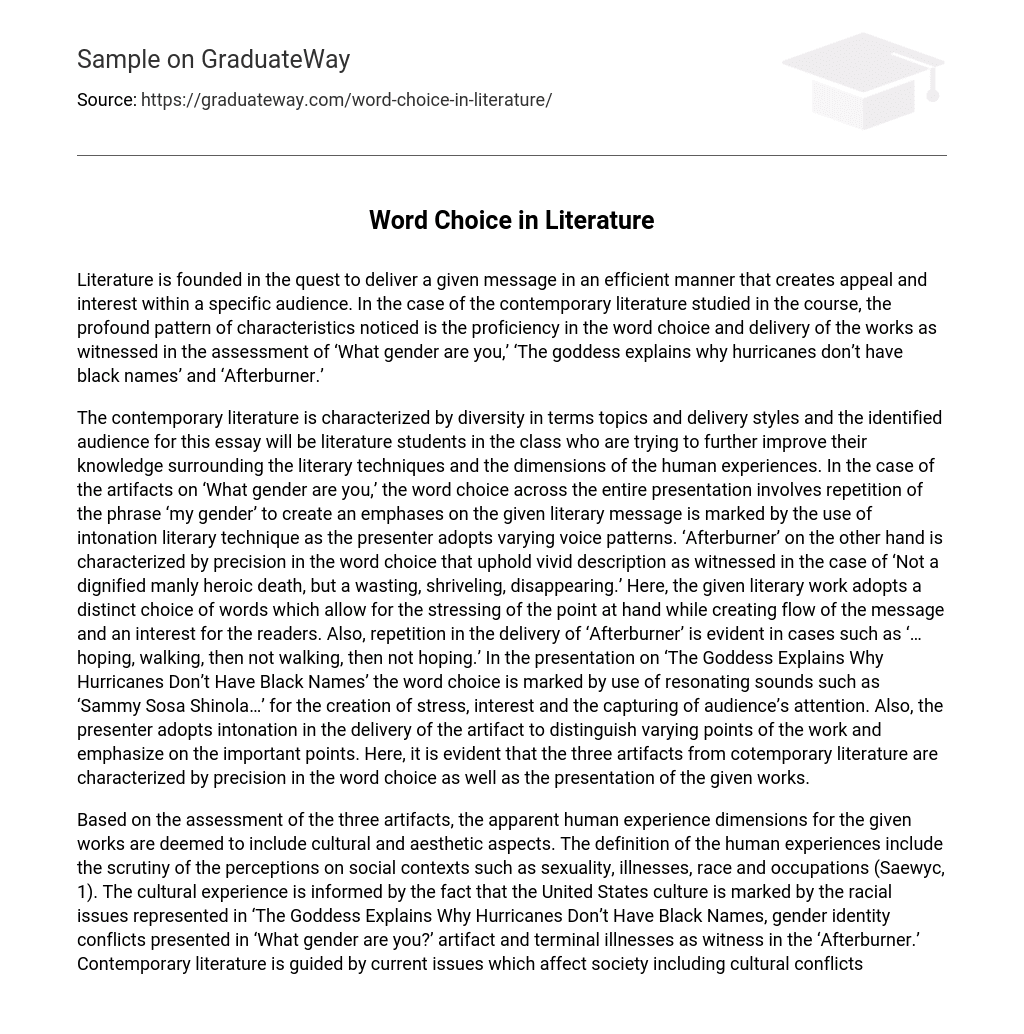Literature is founded in the quest to deliver a given message in an efficient manner that creates appeal and interest within a specific audience. In the case of the contemporary literature studied in the course, the profound pattern of characteristics noticed is the proficiency in the word choice and delivery of the works as witnessed in the assessment of ‘What gender are you,’ ‘The goddess explains why hurricanes don’t have black names’ and ‘Afterburner.’
The contemporary literature is characterized by diversity in terms topics and delivery styles and the identified audience for this essay will be literature students in the class who are trying to further improve their knowledge surrounding the literary techniques and the dimensions of the human experiences. In the case of the artifacts on ‘What gender are you,’ the word choice across the entire presentation involves repetition of the phrase ‘my gender’ to create an emphases on the given literary message is marked by the use of intonation literary technique as the presenter adopts varying voice patterns. ‘Afterburner’ on the other hand is characterized by precision in the word choice that uphold vivid description as witnessed in the case of ‘Not a dignified manly heroic death, but a wasting, shriveling, disappearing.’ Here, the given literary work adopts a distinct choice of words which allow for the stressing of the point at hand while creating flow of the message and an interest for the readers. Also, repetition in the delivery of ‘Afterburner’ is evident in cases such as ‘… hoping, walking, then not walking, then not hoping.’ In the presentation on ‘The Goddess Explains Why Hurricanes Don’t Have Black Names’ the word choice is marked by use of resonating sounds such as ‘Sammy Sosa Shinola…’ for the creation of stress, interest and the capturing of audience’s attention. Also, the presenter adopts intonation in the delivery of the artifact to distinguish varying points of the work and emphasize on the important points. Here, it is evident that the three artifacts from cotemporary literature are characterized by precision in the word choice as well as the presentation of the given works.
Based on the assessment of the three artifacts, the apparent human experience dimensions for the given works are deemed to include cultural and aesthetic aspects. The definition of the human experiences include the scrutiny of the perceptions on social contexts such as sexuality, illnesses, race and occupations (Saewyc, 1). The cultural experience is informed by the fact that the United States culture is marked by the racial issues represented in ‘The Goddess Explains Why Hurricanes Don’t Have Black Names, gender identity conflicts presented in ‘What gender are you?’ artifact and terminal illnesses as witness in the ‘Afterburner.’ Contemporary literature is guided by current issues which affect society including cultural conflicts, handling of the disadvantaged and the protection of the vulnerable groups such as the LGBT (Garces et al.324). Here, the assessment of the three artifacts strives to address the relevant issues affecting the United States culture by adopting the similar pattern on different topics. Health vulnerable populations in the United States include the individuals who are facing terminal illnesses and where aspects of psychology turmoil and effects on the family members are deemed as important social issues (Palmer et al. 1263). Also, the aesthetic experience is formed by the fact that the three artifacts touch on people with similar predicaments; social vulnerability. The terminally ill, minority races and the LGBT fall under a similar category of the vulnerable individuals (Ciszek, 705). While the presentation incorporates a sense of humor, integral issues affecting the society and a certain class of people are being communicated.
While different artifacts in the contemporary literature are founded in distinct messages and target audience, the precision in the choice of words and delivery of the messages is deemed as a common feature. Here, the various presenters are able to stress on the important points while maintaining the audience’s attention and interest on the given message.\
Works Cited
Ciszek, Erica L. “Activist Strategic Communication for Social Change: a Transnational Case Study of Lesbian, Gay, Bisexual, and Transgender Activism. “ Journal of Communication. 67.6 (2017): 702-718
Garces, Liliana M, and da C. C. Gordon. “A Strategic Racial Equity Framework. “ Peabody Journal of Education. 92.3 (2017): 322-342
Palmer, Valerie S, Kathleen I. Birchfield, and Peter S. Spencer. “Health of Vulnerable Populations.” Academic Medicine. 93.9 (2018): 1263-1264
Saewyc, Elizabeth. “A Global Perspective on Gender Roles and Identity.” Journal of Adolescent Health: Supplement. 61.4 (2017)





